Years of service 1939-1945 | Name Michael Strank | |
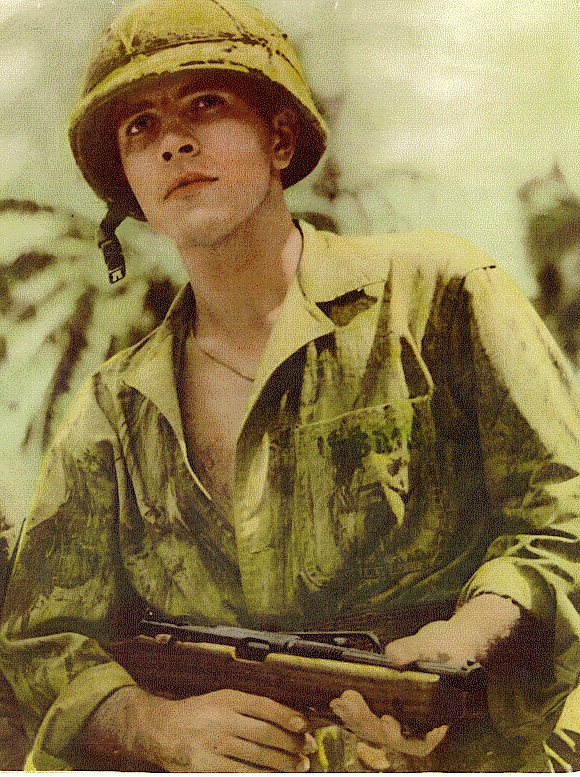 | ||
Allegiance United States of America Battles/wars World War IIBattle of BougainvilleConsolidation of the Northern Solomons (Solomon Islands Campaign)Battle of Iwo Jima Siblings Mary Pero Strank, Peter Strank Parents Martha Grofikova, Vasil Strank Similar People | ||
Monument honoring sgt michael strank to be un
Michael Strank (November 10, 1919 – March 1, 1945) was a United States Marine Corps sergeant who was killed in action during the Battle of Iwo Jima in World War II. He is best known for being one of the six flag-raisers who helped raise the second U.S. flag atop Mount Suribachi on February 23, 1945 as shown in the iconic photograph Raising the Flag on Iwo Jima.
Contents
- Monument honoring sgt michael strank to be un
- Michael strank raising the flag on iwo jima
- Early life
- US Marine Corps
- World War II
- Battle of Iwo Jima
- Death and burial
- Marine Corps War Memorial
- Military awards
- Legacy
- US citizenship
- Monuments and memorials
- Portrayal in film
- References
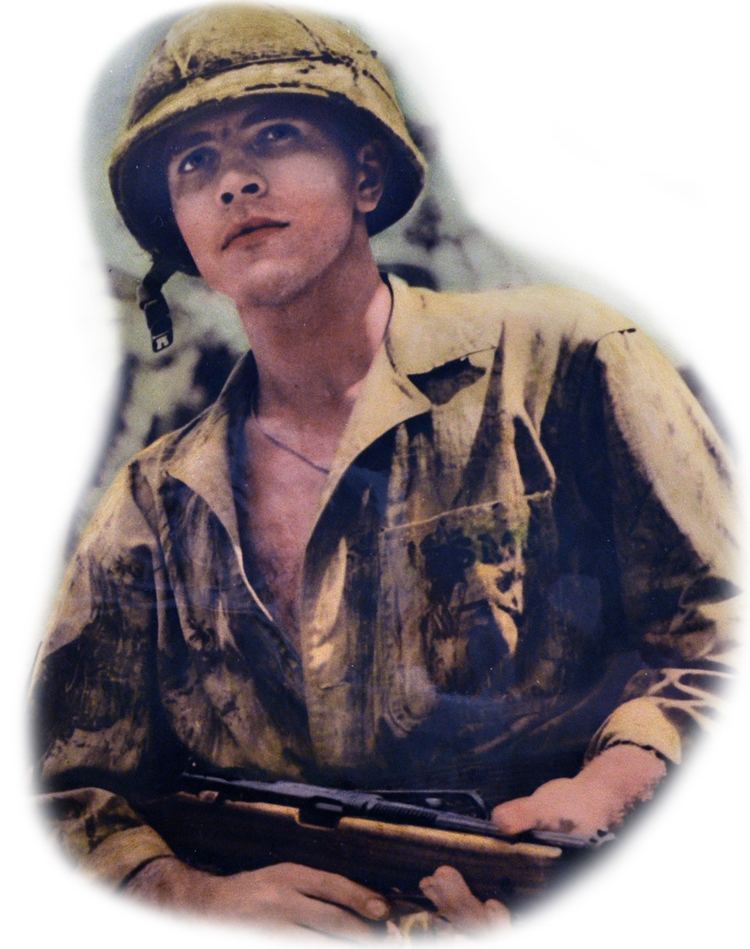
The Marine Corps War Memorial located in Arlington, Virginia, which was modeled after the flag-raising photograph, depicts bronze statues of each of the six Marine flag-raisers.
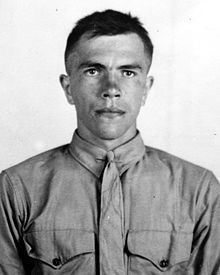
Michael strank raising the flag on iwo jima
Early life
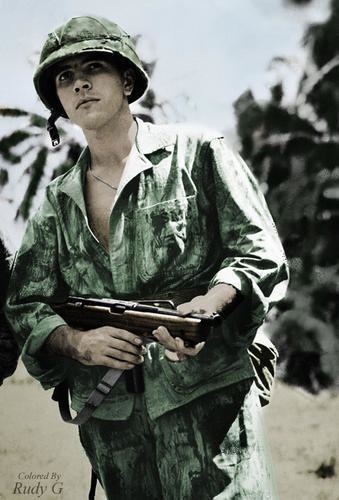
Michael Strank was born in Jarabina, Czechoslovakia (now in Slovakia). He was one of two sons and one daughter of Vasil Strank (later, in the United States, known as Charles Strank) and Marta Grófiková, Ukrainian-Lemko natives of a Carpatho-Rusyn village. Vasil Strank moved to Franklin Borough (near Johnstown, Pennsylvania, United States), found work in the coal mines for the Bethlehem Steel Corporation, and brought his family to Pennsylvania three years later, when he could pay for their voyage. Strank attended the public schools of Franklin Borough and graduated from Franklin Borough High School in 1937. He joined the Civilian Conservation Corps, served for 18 months, and afterwards became a Pennsylvania state highway laborer.
U.S. Marine Corps
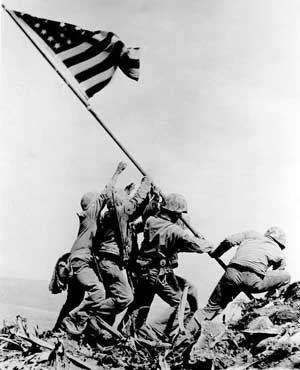
Strank enlisted in the Marine Corps at Pittsburgh for four years service on October 6, 1939. He was assigned to the Marine Corps Recruit Depot Parris Island in South Carolina. He completed recruit training in December and was transferred to Headquarters Company, Post Troop and then to Provisional Company W at Parris Island, on January 17, 1941. Private First Class Strank sailed for Guantánamo Bay, Cuba, arriving on January 23, 1941. He was reassigned to Headquarters Company, 3rd Battalion, 7th Marines, 1st Marine Brigade (on February 1, the 1st Marine Brigade was redesignated the 1st Marine Division). On April 8, now assigned to Company K, he returned to the United States and was sent back to Marine Corps Recruit Depot Parris Island. He was promoted to corporal on April 23, 1941. In September, Strank moved with the 1st Marine Division to New River, North Carolina, which is where he was stationed when the attack on Pearl Harbor occurred.
World War II

On January 26, 1942, Strank was promoted to sergeant. In early April, he was sent with the 3rd Battalion, 7th Marines to San Diego, California and shipped out of there on April 12. On May 31, 1942, his battalion landed on the island of Uvea. In September, after a short time with the 22nd Marine Regiment, he was transferred to the 3rd Marine Raider Battalion also on Uvea. As a member of the "3rd Raiders", he participated in the landing operations and occupation of Pavuvu in the Russell Islands from February 21 to March 18, 1943 and in the seizure and occupation of the Empress Augusta Bay during the Battle of Bougainville from November 1 to January 12, 1944. On February 14, 1944, when his and the other Marine Raider units were in the process of being disbanded, he was sent to San Diego and allowed a leave to visit his family.
Battle of Iwo Jima
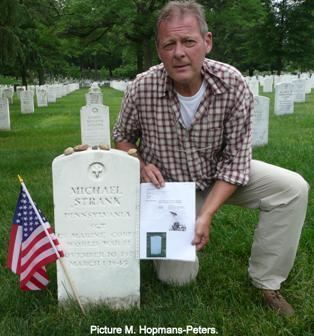
Strank returned to duty in San Diego and was assigned to Second Platoon, Company E, 2nd Battalion, 28th Marine Regiment, 5th Marine Division at Marine Corps Base Camp Pendleton, as a squad leader. He was sent to Hawaii with his unit after extensive training, and began more training and preparation for the invasion of Iwo Jima.
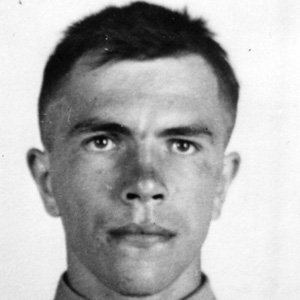
First flag-raising
Strank took part in the 28th Marines amphibious assault landing at the southern part of Iwo Jima near Mount Suribachi on February 19, 1945. The 28th Marines mission was to capture Mount Suribachi. At 8 AM on the morning of February 23, E Company's executive officer, First Lieutenant Harold Schrier, led a 40-man patrol whose members were mostly from Third Platoon, E Company, up 556-foot high Mount Suribachi to seize and occupy the crest. Once the top was secure by Lt. Schrier and his men, the Second Battalion's flag Schrier carried was attached to a steel Japanese water pipe by Lt. Schrier, Sgt. Henry Hansen, and Cpl. Charles Lindberg. The flag was taken to the highest position on the crater and raised and planted by Lt. Schrier, Platoon Sergeant Ernest Thomas, and Sgt. Hansen at about 10:30 AM.
Second flag-raising
In order for the American flag to be seen more easily from the ships, beaches, and land on the north side of Mount Suribachi (where more Japanese soldiers were located and more fighting would occur in the days ahead), it was decided that another larger flag should be flown on Mt. Suribachi. Strank was ordered by E Company's commander to ascend Mount Suribachi with three Marines from his rifle squad in Second Platoon and raise the replacement flag. Strank then ordered Cpl. Harlon Block, Pfc. Ira Hayes, and Pfc. Franklin Sousley to go with him up Mount Suribachi with supplies. Pfc. Rene Gagnon, the Second Battalion's runner (messenger) for E Company, was ordered to take the replacement flag up the mountain and return with the first flag that was flying on top.
Once Strank's team was on top (after Gagnon), Hayes and Sousley found a Japanese pipe to attach the flag on. Once that was done, the flagstaff was placed close to first flag's position and, under Lt. Schrier's orders, the replacement flag was raised at approximately 1 PM by Strank, Hayes, Sousley, and Block (Sgt. Hansen was incorrectly identified after the battle as being at the base of the flagstaff where Block was until January 1947), Gangon (Strank called for Gagnon and another Marine to help), and Pfc. Harold Schultz, a member of the 40-man patrol who was present at the first flag-raising (the Marine Corps announced on June 23, 2016, that Schultz raised the flag and Navy corpsman John Bradley did not), as the original flag came down. In order to keep the flagstaff in a vertical position in the high winds on the summit, rocks were immediately added to the base of the flagstaff by Gangon and Schultz and others nearby. A rope was then tied to the flagstaff which was staked to the ground in three places (Bradley assisted the Marines using the rope).
The six Marine flag-raisers were photographed in mid-action by Associated Press photographer Joe Rosenthal and by Marine motion picture cameraman Sergeant William (Bill) Genaust (later killed in action) in color. After the second flag-raising, Rosenthal photographed sixteen Marines including Strank, and two Navy corpsmen, around the base of the flagstaff. Rosenthal's black and white flag-raising picture which appeared in newspapers on Sunday, February 25, 1945, was later titled Raising the Flag on Iwo Jima. It became the most copied photograph in history or at least in Marine Corps history. By late March 1945, Sgt. Strank, Cpl. Block, and Pfc. Sousley, were killed in action (Platoon Sgt. Ernest Thomas and Sgt. Henry Hansen of the first flag-raising were also killed).
Death and burial
On February 28, Strank and E Company moved northward. Fighting was heavy, and both the Japanese and the American forces were taking heavy casualties. On March 1, Strank's rifle squad came under heavy fire and took cover. While forming a plan of attack, he was killed by friendly artillery fire. The shell that killed him was almost certainly fired from offshore by an American ship. Cpl. Harlon Block, Strank's assistant squad leader, took command of the squad. Block was killed later on the same day by a Japanese mortar shell. However, Ralph Griffiths of Second Platoon, Easy Company, claimed that Strank and Block were on both sides of him on March 1 and were killed by the same shell that also wounded him. Strank and the other Marines killed in action of the 28th Regiment were buried in the 5th Marine Division Cemetery on the island with the last rites of the Roman Catholic Church. Strank (and possibly Block) was the first person in the Rosenthal's flag raising photograph to be killed. On January 13, 1949, his remains were reinterred in Grave 7179, Section 12, Arlington National Cemetery.
Strank's brother Peter Strank, was serving aboard the aircraft carrier USS Franklin in the South Pacific when Michael Strank was killed.
Marine Corps War Memorial
The Marine Corps War Memorial (also known as the Iwo Jima Memorial) in Arlington, Virginia, which was inspired by Rosenthal's photograph of the second flag-raising on Mount Suribachi, was dedicated on November 10, 1954. Michael Strank is depicted as the fourth bronze statue from the base of the flagstaff on the monument with the 32 foot (9.8 M) bronze statues of the other five flag-raisers on the monument (as of June 23, 2016, Franklin Sousley and Harold Schultz are depicted as the third and fifth bronze statues from the bottom of the flagstaff).
President Dwight D. Eisenhower sat upfront with Vice President Richard Nixon, Deputy Secretary of Defense Robert Anderson, and General Lemuel C. Shepherd, the 20th Commandant of the Marine Corps during the dedication ceremony. Two of the three surviving flag-raisers depicted on the monument, Ira Hayes and Rene Gagnon, were seated together with John Bradley (he was incorrectly identified as a surviving flag-raiser) in the front rows of seats along with relatives of those who were killed in action on the island. Speeches were given by Richard Nixon, Robert Anderson who dedicated the memorial, and General Shepherd who presented the memorial to the American people. Inscribed on the memorial are the following words:
In Honor And Memory Of The Men of The United States Marine Corps Who Have Given Their Lives To Their Country Since 10 November 1775Military awards
Strank's military decorations and awards include:
Legacy
Strank was born on November 10, the Marine Corps birthday. The members of Sgt. Mike Strank's rifle squad idolized him (Cpl. Harlon Block for one followed his every instruction without question), and many men since who served with and alongside him have stated he had a way of setting them at ease, making them feel that he could help them survive the war. Of the men photographed raising the second flag on Iwo Jima, Strank at age 25, was the oldest and most experienced in combat.
In interviews of former Marines conducted years later, many documented in the book Flags of Our Fathers written by James Bradley (son of corpsman John Bradley), he is described by men who served with him as "a Marine's Marine", a true warrior and leader, who led his men by example. Strank often told his men, "Follow me, and I'll try to bring you all safely home to your mothers." One former Marine who served with Strank stated, "He was the kind of Marine you read about, the kind they make movies about." L.B. Holly, who served in Strank's squad and who was with Strank when he died, stated, "He was the best Marine I ever knew."
U.S. citizenship
In 2008, Gunnery Sergeant Matt Blais, who was a Marine security guard in the American Embassy in Slovakia, discovered that Strank was not a natural-born U.S. citizen. Strank had become a U.S. citizen after his father's naturalization in 1935, but had never received official documentation. GySgt. Blais petitioned the United States Citizenship and Immigration Services on Strank's behalf and on July 29, 2008, Strank's youngest sister, Mary Pero, was presented with his certificate of citizenship in a ceremony at the Marine Corps War Memorial.
Monuments and memorials
Strank's public recognitions include:
Portrayal in film
Michael Strank is prominently featured in the 2006 movie Flags of Our Fathers. In the movie, Sgt. Strank is played by Canadian actor Barry Pepper. The movie is based on the 2000 book of the same title. In 2016 Radio and Television of Slovakia has filmed a document about Sgt. Strank called "Chlapec, ktorý chcel byť prezidentom" ("The boy who wanted to be a president"). It was aired for the first time on the 2nd May 2017.
